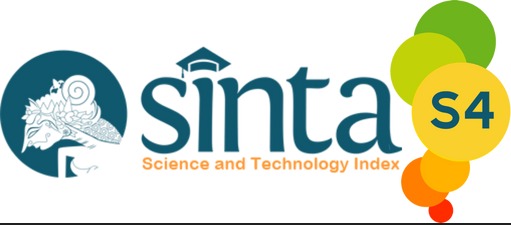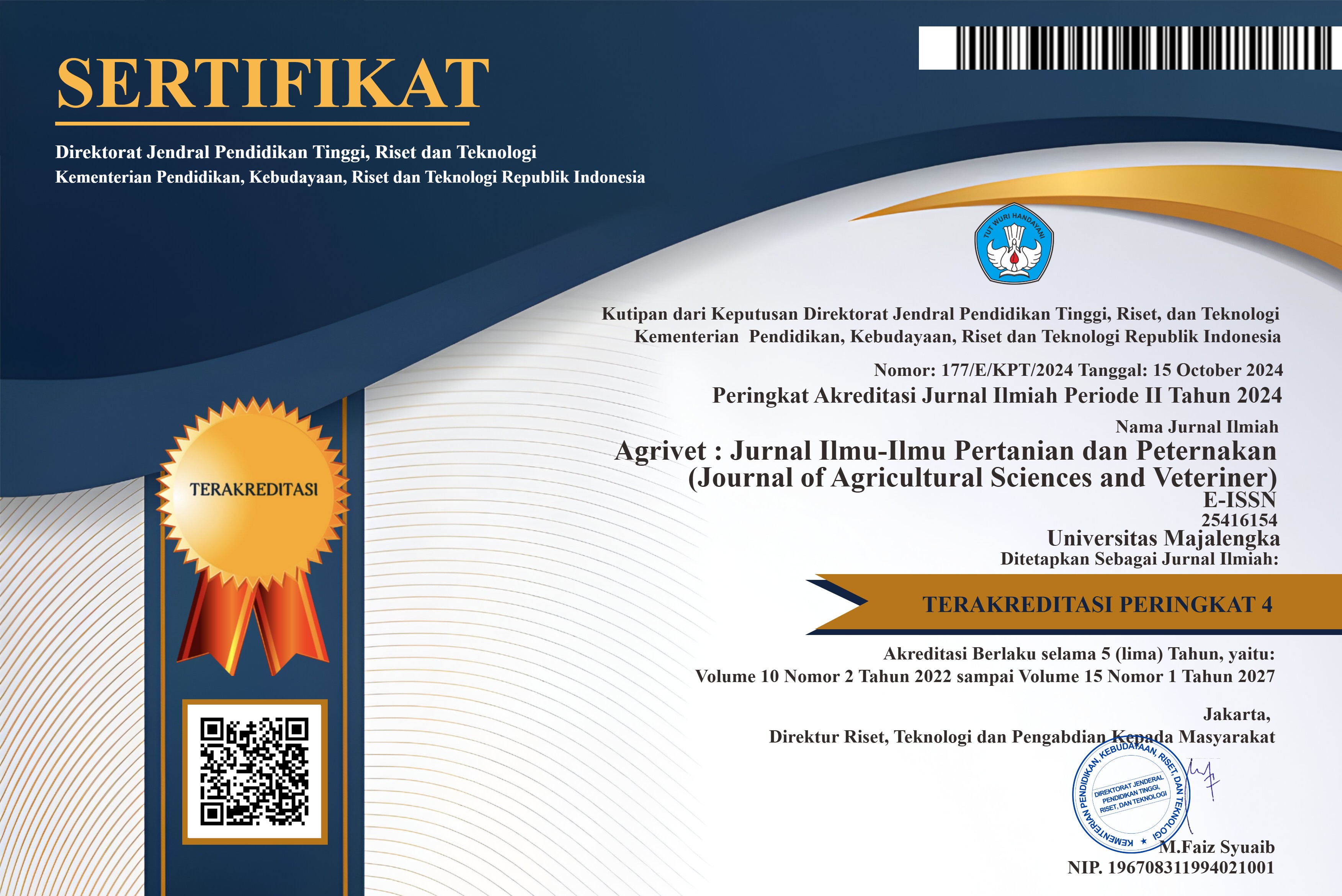Efektivitas penambahan tepung jahe merah dalam ransum terhadap bobot potong, bobot karkas, dan presentase karkas burung puyuh jantan umur 6 minggu
DOI:
https://doi.org/10.31949/agrivet.v11i2.5864Abstract
This study aimed to determine the effectiveness of adding red ginger meal to the ration on slaughter weight, carcass weight, and carcass percentage of 6-week-old male quail. This research was conducted in the Experimental Field of HKBP University, Nommensen, Medan. Two hundred male quail aged 1-6 weeks were randomly separated into four treatments and five replications so that each replication contained 10 quail. The four additional doses of the red ginger meal were 0% (P0 as a control), 0.75% (P1), 1.5% (P2), and 2.25% (P3). The research was carried out for 30 days to determine the impact on slaughter weight, carcass weight, and carcass percentage. The data obtained were analyzed using ANOVA and further tested using the Duncan Multiple Range Test (DMRT). The results showed that all observed variables did not show significant differences (P>0.05). However, adding 1.5% red ginger meal to the male quail's ration revealed a tendency for better results than other treatment doses. It can be concluded that adding red ginger meal to the male quail's ration is quite safe and has not been proven to impact carcass quality negatively.
Keywords:
Persentase karkas, Puyuh, Jahe, RansumDownloads
References
Amrullah, I.K. 2003.Nutrisi Ternak Unggas.Lembaga Satu Gunung Budi. Bogor.
Anonimous. 2013. Kandungan Nutrisi Pakan Komersial Bravo 511 untuk Fase Starter dan Bravo 512 untuk fase grower. PT. Charoen Pokphand Indonesia.
Anonimous 2017. Standard Kebutuhan Pakan Burung Puyuh. PT. Peksi Guna Harja
Dicky, R. B. 2020.Pengaruh Penambahan Probiotik Starbio dalam Ransum terhadap Bobot Potong, Bobot Karkas dan Persentase Karkas Burung Puyuh Umur 6 Minggu. Skripsi. Fakultas Peternakan Univ. HKBP Nommensen. Medan.
Herawati. 2006. Pengaruh Penambahan Fitobiotik Jahe Merah (Zingiber officinale Rosc) terhadap Produksi dan Profil Darah Ayam Broiler. Jurnal Ilmu Peternakan Vol. 14 No.2Tahun2006. FakultasPeternakan. UniversitasMuhammadiyah Purworejo.
Kehinde, A.S., C.O. Obun, M. Inuwa, O. Bobadoye. 2011. Growth Performance, HaematologicalandSerumBiochemicalIndicesofCockerelChicks forGinger (Zingiber officinale) Additivein Diets.A. Res. Int 8 (2): 1398– 1404.
Nahashon, S. N., Adefope, A. Amenyenu and D. Wright. 2005.Effect of Dietary Metabolizable Energy & Crude Protein Concentration on Growth Performance and Carcass Characteristics of French Guinea Broiler. Poultry. Sci. 84 (2): 337-344.
Nugroho dan I. G. K. Mayun. 1990. Beternak Burung Puyuh. Eka Offset, Semarang.
Nugroho, E. dan I. G. K. Mayun.1993. Budidaya Burung Puyuh. Eka Offset. Semarang.
Rahimian, Y., Kheiri, F., & Moghaddam, M. 2018. Effect of using ginger, red and black pepper powder as phytobiotics with protexin® probiotic on performance, carcass characteristics and some blood biochemical on Japanese quails (Coturnix japonica). Veterinary Science Development, 8(1). https://doi.org/10.4081/vsd.2018.7528
Risnajati, D.2012. Perbandingan Bobot Akhir, Bobot Karkas dan Persentase Karkas Berbagai Strain Broiler. Jurnal Sains Peternakan, 10 (1), 11-14.
Sastrosupadi A. 2013. Rancangan Percobaan Praktis Bidang Pertanian. Kanisius, Yogyakarta.
Soeparno. 2005. Ilmu dan Teknologi Daging Cetakan ke IV, Gadjah Mada University Press. Yogyakarta.
Soraya, Fajrin, Hasibuan. 2019. Pemberian Tepung Daun Papaya dalam Ransum terhadap Karkas Burung Puyuh. Jurnal Perternakan. Vol .3.
Tillman, A. D., H. Hartadi, Reksohadiprojo, S. Prawirokusumo. Dan S. Lebdosoekojo. 1998. Ilmu Makanan Ternak Dasar. Edisi Keenam. Gadjah Mada University Press.Yogyakarta.
Winarto,W.P. 2003. Khasiatdan Manfaat Kunyit.Agromedia Pustaka. Jakarta.
Wuryadi, S. 2011. Buku Pintar Beternak dan Bisnis Puyuh.Agromedia Pustaka. Jakarta. Hal.16-18.
Published
How to Cite
Issue
Section
License
Copyright (c) 2023 Magdalena Siregar

This work is licensed under a Creative Commons Attribution-ShareAlike 4.0 International License.
An author who publishes in the Jurnal Agrivet agrees to the following terms:
- Author retains the copyright and grants the journal the right of first publication of the work simultaneously licensed under the Creative Commons Attribution-ShareAlike 4.0 License that allows others to share the work with an acknowledgment of the work's authorship and initial publication in this journal
- The author is able to enter into separate, additional contractual arrangements for the non-exclusive distribution of the journal's published version of the work (e.g., post it to an institutional repository or publish it in a book) with the acknowledgment of its initial publication in this journal.
- The author is permitted and encouraged to post his/her work online (e.g., in institutional repositories or on their website) prior to and during the submission process, as it can lead to productive exchanges, as well as earlier and greater citation of the published work









